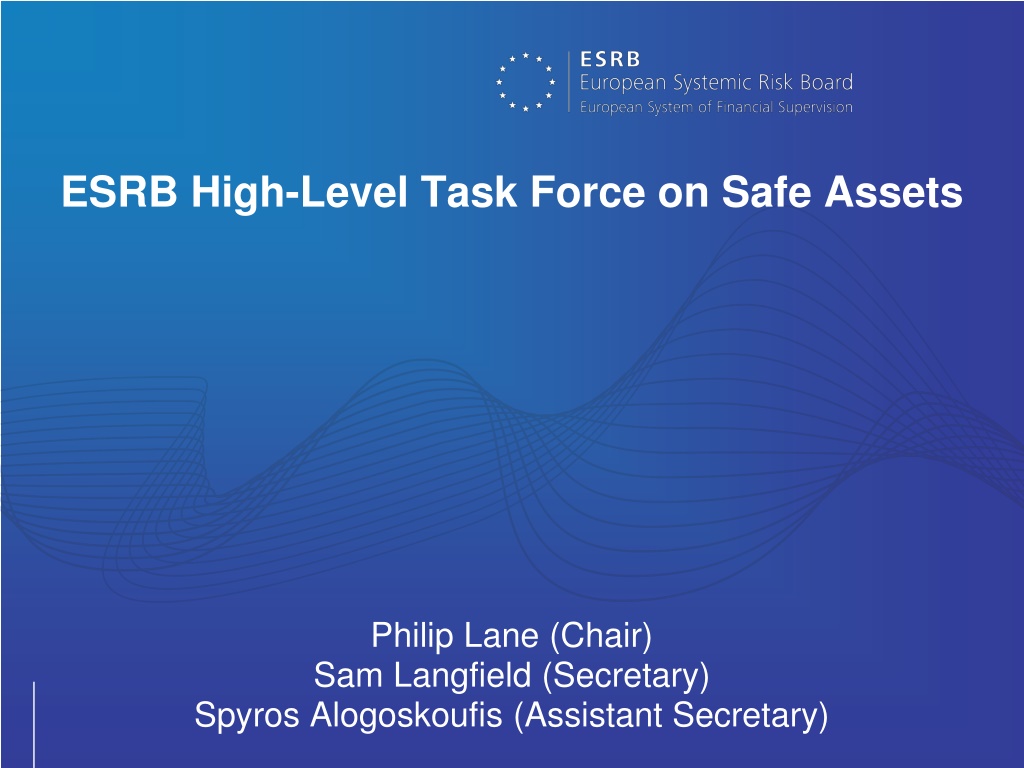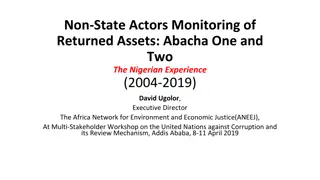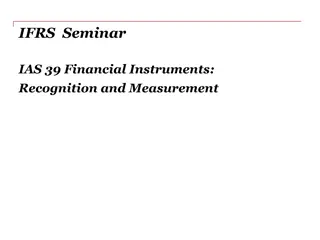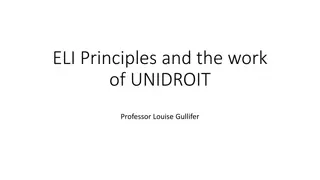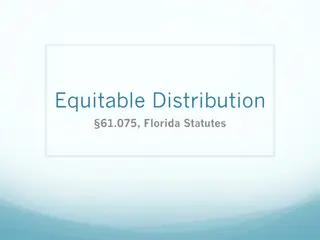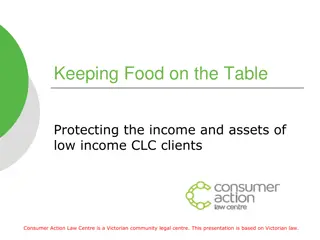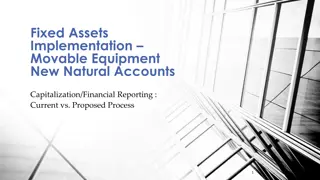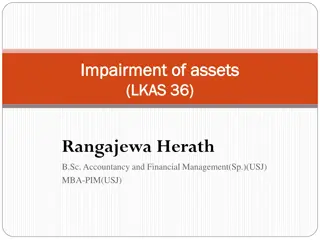Exploring Regulatory Barriers in the Development of Safe Assets
The ESRB High-Level Task Force on Safe Assets, led by Philip Lane, delves into the challenges surrounding safe assets like sovereign bonds. The task force's technical contribution sheds light on the unique properties of Sovereign Bond-Backed Securities (SBBS) and their potential role in enhancing financial stability. Key findings highlight regulatory barriers hindering the development of SBBS and the need for tailored enabling regulations to drive market demand.
Download Presentation

Please find below an Image/Link to download the presentation.
The content on the website is provided AS IS for your information and personal use only. It may not be sold, licensed, or shared on other websites without obtaining consent from the author. Download presentation by click this link. If you encounter any issues during the download, it is possible that the publisher has removed the file from their server.
E N D
Presentation Transcript
ESRB High-Level Task Force on Safe Assets Philip Lane (Chair) Sam Langfield (Secretary) Spyros Alogoskoufis (Assistant Secretary)
Safe Assets: Some Issues Sovereign bonds: benchmark assets Large stock; trading liquidity; common information base Collateral function in many market transactions Sovereign risk ? Multi-country monetary union; national-level fiscal liabilties (no joint mutualisation) Doom loop between domestic banking system and domestic sovereign
Background to the creation of the ESRB HLTF on Safe Assets In June 2016, the ESRB GB established a HLTF to further investigate the empirical and practical considerations related to sovereign bond-backed securities (SBBS) SBBS represent an idea to create an area-wide low-risk asset without fiscal mutualisation Securities would be created by pooling and tranching cross-border portfolios of national sovereign bonds Over past 18 months, HLTF has conducted analysis and gathered insights from market participants on feasibility of SBBS
HLTFs technical contribution sheds light on SBBS HLTF s contribution is technical: sheds light on unique properties of SBBS and their potential role in enhancing financial stability Two-volume report summarizes the HLTF s findings: Volume I: 50 pages covers: motivation for SBBS; security design; market development; and regulation Volume II: 250 pages covers: risk measurement; contractual features; market intelligence; market liquidity; and a more detailed analysis of regulation Report will be published shortly
HLTFs main finding: there are regulatory barriers to SBBS SBBS represent one interesting and attractive option for the design of an area-wide low-risk asset Gradual development of a demand-led market for SBBS may be feasible under certain conditions One necessary condition is for an SBBS-specific enabling regulation to reflect the unique design and risk properties of these securities The level of investor demand for SBBS is an empirical question, which can only be tested with an SBBS-specific regulation that removes existing impediments
Regulatory Treatment of Sovereign Exposures (RTSE) HLTF has not attempted to assess RTSE options: the focus was on SBBS, not RTSE From the perspective of SBBS, it is clear that certain RTSE reform options would substantially enhance demand for the securities This finding does not provide sufficient justification for embarking on RTSE reform, which should be evaluated on its own merits in other policy fora The HLTF report acknowledges the differing policy positions of HLTF members with respect to RTSE
Motivation for SBBS: financial stability and integration SBBS could contribute to financial stability by supporting efforts to complete banking and capital markets unions Reduce systemic risks by weakening the bank-sovereign nexus Combination of diversification and de-risking of bank sovereign bond portfolios Reduce barriers to further financial integration SBBS could be used to collateralize area-wide transactions A mature SBBS market could provide an area-wide benchmark for asset pricing But SBBS not a panacea: they stand alongside other policy initiatives to complete BU and CMU and deepen EMU
Basic security design reflects policy objectives Security design is a policy choice: On asset side, designed to be area-wide On liability side, designed for senior to be low risk (based on Volume II simulations) and non-senior to be marketable (based on market intelligence) Pooling diversification A L Tranching seniority Portfolio of euro- denominated central government bonds (based on capital key) 70% Senior 20% Mezz 10% Junior
Risk properties of SBBS: insights from market data Structure 70:20:10 Senior Mezzanine Junior Historical simulation: Long-term averages: Estimated Yields and EL 2000-2016 (DE = s) < FI BE < (IT = m = ES) < IE PT << j << GR 2000-2016 NL < (DE = s = AT) < (BE = FR) ES < (IT = m) << IE IE < (PT = j) << GR Market 1%VaR 2000-2016 FI < (DE = s = AT) < FR ES < (IT = m) << IE IE < (PT = j) << GR Market 1%ES Historical simulation: Crisis times: Estimated Yields and EL 2011-2012 DE < s < FI BE < (IT = m) < ES PT << j << GR June 2012 DE < s < FI BE < (IT = m) < ES PT << j << GR 2011-2012 DE < (AT = FR = s = NL) << BE ES < (IT = m) << PT IT << (j = PT = IE) << GR Market 1%VaR 2011-2012 DE < (AT = FR = s = NL) << BE ES < (IT = m) << PT IT << (j = PT = IE) << GR Market 1%ES June 2012 DE = s = NL ES = m < PT PT < j < GR VAR-for-VaR 1%VaR June 2012 DE = s = FI PT < m < GR PT < GR < j Garch Volatility
How would SBBS be issued? Each government still issues and services its own bonds SBBS arranger(s) buy some sovereign bonds on primary or secondary markets at market prices If a bond does not have a market price, it would not be included in the portfolio SBBS arranger(s) could be private or public Private: Multiple arrangers would need to be regulated and supervised Public: Single arranger would require institutional framework to preclude perception of joint guarantees SBBS issuers are bankruptcy-remote pass-through entities Issuers bear no risk on their own account: they receive portfolio directly from SBBS arranger(s), and pass cash flows to SBBS investors according to seniority 11
Incremental development of an SBBS market SBBS issuance would be demand-led Issued only insofar as there is investor demand for the three securities SBBS market would develop gradually Early phase: Similar to ESM bond market development Transitional phase: Market grows gradually (e.g. to 1.5tn), conditional on smooth market functioning Market size can be controlled by policymakers Unintended side-effects can be managed by rationing the issuance of SBBS license numbers
Ambiguous effects on sovereign bond market liquidity Freezing effect (-ve): Sovereign bonds frozen on SBBS issuers balance sheets Spillover effect (+ve): Liquid SBBS could be used to reduce hedging costs
Investment-enhancing effect from non-euro investors Holdings of government bonds Holdings of supranational bonds EA banks: 87bn (11%) Non-EA investors: 2.3tn (26%) EA banks: 1.5tn (17%) Non-EA investors: 410bn (50%) Eurosystem: 178bn (22%) EA non-financials: 0.4tn (4%) Eurosystem: 1.8tn (20%) EA insurance corporations and pension funds: 77bn (9%) EA other financial institutions: 0.2tn (2%) EA insurance firms: 1.5tn (17%) EA pension funds: 0.3tn (3%) EA asset managers: 40bn (5%) EA investment funds (non-MMF): 0.9tn (10%) EA other: 23bn (3%) 15
Regulation: necessary to remove existing barriers At present, SBBS receive unfavourable regulatory treatment Sufficient reason why the securities have not yet been created by markets One necessary condition for market creation is to treat SBBS in line with their unique design and risk properties Senior SBBS: Analysis in Volume II suggests that they should be treated no more severely than sovereign bonds Non-senior SBBS: Treatment should reflect their greater riskiness An enabling SBBS-specific product regulation could remove existing barriers by providing a new treatment for all sectors
Conclusion and next steps SBBS represent one interesting and attractive option for the design of an area-wide low-risk asset Gradual development of a demand-led market for SBBS may be feasible under certain conditions Necessary to remove regulatory barriers to market development Next step: publish report to better inform policy discussions Past contributions from market participants are expected to be revised as report brings to light new information
